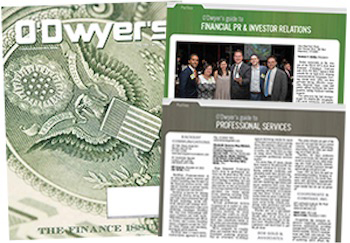|
|
Pity the poor PR practitioner. Despite an explosion in social media, the traditional media relations landscape is shrinking dramatically, and with it go the chances of landing substantial ink for their clients’ stories.
Every day comes news of another journalism giant axing a major part of its leading daily newspaper. Business/finance sections are shrinking, and many papers are now using wire service reports for national news and sometimes even reviews.
|
|
Thinner newspapers and magazines mean fewer opportunities for PR practitioners to feature their clients. In many cases, not only are there fewer reporters per beat — for instance, one or two finance journalists instead of a whole team — but the talented few remaining may be asked to be a Jack or Jill of all trades. For example, it’s not unusual for the lifestyle reporter to also be reviewing local restaurants or for the tech specialist to also cover new products.
All of this compression means that media relations specialists need to be savvier and craftier than in the past to land a big story. The news angle you’re pitching needs to stand out in a crowd more than ever but also be urgent enough for the targeted reporter to make time for your story amid ever-decreasing chunks of available time and space.
A frequent complaint of journalists is that PR people don’t read their stories or their publication at all. It’s now crucial to get to know deeply the outlet you’re targeting. Yes, you can look up reporters’ beats on Cision, but there’s no way to truly know the actual possibilities for your client’s story short of picking up the paper and studying it or logging on to its site frequently.
You’ll see that the finance writer sometimes covers tech stories or that a business writer will often do reviews of a new consumer product. Supplement your reading of the paper with a Google search. That is, once you find out which reporter you are targeting, then comb through his/her past stories to see the breadth of their expertise and coverage.
If the business reporter you think is best for your cybersecurity story has written a good deal in the past about hackings and malware, then you’ve done your homework and can feel comfortable about speaking with him/her about interviewing your ransomware expert. You probably wouldn’t have known this just by looking at a media database, since fewer reporters mean less specialization; a business reporter these days just may cover every aspect of the business world.
In addition, it’s imperative to hone in on why your story should be covered right away. Less space means that many pitches that would have been considered worthy of a story 10 years ago will now be discarded in favor of more urgent ideas. Make sure you convey to the reporter you target that your startup is now currently developing the state-of-the-art solution to a key business need whether it’s keeping networks secure or distributing knowledge quickly and efficiently throughout an organization. A reporter is more likely to call you back if you can tell him/her your client has the best solution to a common problem and that it is available now rather than in a few months.
The shrinking media landscape also means that PR executives must consider ever more carefully where to shop their stories. Daily newspapers as thick as the New York Times are becoming a thing of the past. It’s also true that the number of magazines is heading down, but they still offer more opportunities because they specialize in either a specific industry or locale. Your Boston-based client will have a greater chance of getting ink in a publication that specializes in Massachusetts rather than in the Boston Globe, since the amount of space for stories about local businesses has been greatly reduced in daily newspapers. Also, be sure to consider getting your client in industry publications. These magazines might not have the circulation of a large newspaper but they have at their disposal reporters who specialize in tech, pharma, finance or whichever area in which your client excels. These reporters might have worked once at a big newspaper while now they are earning a living at the best periodicals which cover the industry in which they specialize.
A decade ago, a client may have scoffed at a story about their company appearing only online, but these days a significant amount of space for your story in a major online outlet such as The Daily Beast or The Huffington Post is considered a coup. Some of these websites also are bucking the trend and often adding reporters rather than letting them go.
And the fact that every terrestrial media giant has an online counterpart just as influential in effect doubles your chances of coverage. When dealing with a huge media entity such as Forbes, it’s wise to do your homework and investigate sections relevant to your clients’ expertise both in the hard copy magazine as well as on forbes.com. This publication is a great example of one that often has separate reporters — some online and some in print — covering the same beat. Often this means you’ll be lucky enough to secure a story in at least one of these mediums, and if you really hit the bullseye you might be able to score with your client appearing both in the actual publication as well as on its website.
The important thing is to not look at media these days and get discouraged. Yes, the number of reporters at media organizations of all sizes is decreasing. But every month there’s likely a new website popping up in your client’s field or an established publication is launching an online section that covers your client’s industry.
Also, being a PR executive today means you must have extreme patience. Unless your news is breaking news, it is likely that your client’s story will take time to get into print. The fact that many reporters now wear more than one hat means that it’s taking them longer to research, write, finish and then get editorial permission to publish.
Today’s successful public relations executive knows that it’s important to do more thorough media research on the possibilities still out there for coverage and to cast their nets wide to see what “fish” of all types they can pull in. If you’re lucky, you have a client knowledgeable enough to appreciate that a solid mixture of online, trade and general publications on your company pack just as much of a punch as an article in a major daily newspaper.
Pity the poor PR practitioner? Maybe not just yet.
***
Frank Tortorici leads Marketing Maven’s finance and professional services media relations. He can be reached at [email protected].

 Frank Tortorici
Frank Tortorici

 Southern governors claim they know what's best for their working class, and it's not pay raises... A Ukrainian human rights group played a key role in convincing House Speaker Mike Johnson to hold a vote to send arms to Ukraine, Israel and Taiwan... Trump Media & Technology Group blames short-selling and not lousy outlook for its stock slump.
Southern governors claim they know what's best for their working class, and it's not pay raises... A Ukrainian human rights group played a key role in convincing House Speaker Mike Johnson to hold a vote to send arms to Ukraine, Israel and Taiwan... Trump Media & Technology Group blames short-selling and not lousy outlook for its stock slump. The techniques deployed by OJ Simpson's defense team in the 'trial of the century' served as a harbinger for those used by Donald Trump... People worry about the politicization of medical science just as much as they fret about another pandemic, according to Edelman Trust Barometer... Book bans aren't restricted to red states as deep blue Illinois, Connecticut and Maryland challenged at least 100 titles in 2023.
The techniques deployed by OJ Simpson's defense team in the 'trial of the century' served as a harbinger for those used by Donald Trump... People worry about the politicization of medical science just as much as they fret about another pandemic, according to Edelman Trust Barometer... Book bans aren't restricted to red states as deep blue Illinois, Connecticut and Maryland challenged at least 100 titles in 2023. The NBA, which promotes legalized gambling 24/7, seems more than hypocritical for banning player for placing bets... Diocese of Brooklyn promises to issue press release the next time one of its priests is charged with sexual abuse... Truth Social aspires to be one of Donald Trump's iconic American brands, just like Trump University or Trump Steaks or Trump Ice Cubes.
The NBA, which promotes legalized gambling 24/7, seems more than hypocritical for banning player for placing bets... Diocese of Brooklyn promises to issue press release the next time one of its priests is charged with sexual abuse... Truth Social aspires to be one of Donald Trump's iconic American brands, just like Trump University or Trump Steaks or Trump Ice Cubes. Publicis Groupe CEO Arthur Sadoun puts competition on notice... Macy's throws in the towel as it appoints two directors nominated by its unwanted suitor... The Profile in Wimpery Award goes to the Ford Presidential Foundation for stiffing American hero and former Wyoming Congresswoman Liz Cheney.
Publicis Groupe CEO Arthur Sadoun puts competition on notice... Macy's throws in the towel as it appoints two directors nominated by its unwanted suitor... The Profile in Wimpery Award goes to the Ford Presidential Foundation for stiffing American hero and former Wyoming Congresswoman Liz Cheney. JPMorgan Chase chief Jamie Dimon's "letter to shareholders" is a must-read for PR people and others interested in fixing America and living up to its potential... Get ready for the PPE shortage when the next pandemic hits... Nixing Netanyahu. Gaza carnage turns US opinion against Israel's prime minister.
JPMorgan Chase chief Jamie Dimon's "letter to shareholders" is a must-read for PR people and others interested in fixing America and living up to its potential... Get ready for the PPE shortage when the next pandemic hits... Nixing Netanyahu. Gaza carnage turns US opinion against Israel's prime minister.


 Have a comment? Send it to
Have a comment? Send it to 
No comments have been submitted for this story yet.